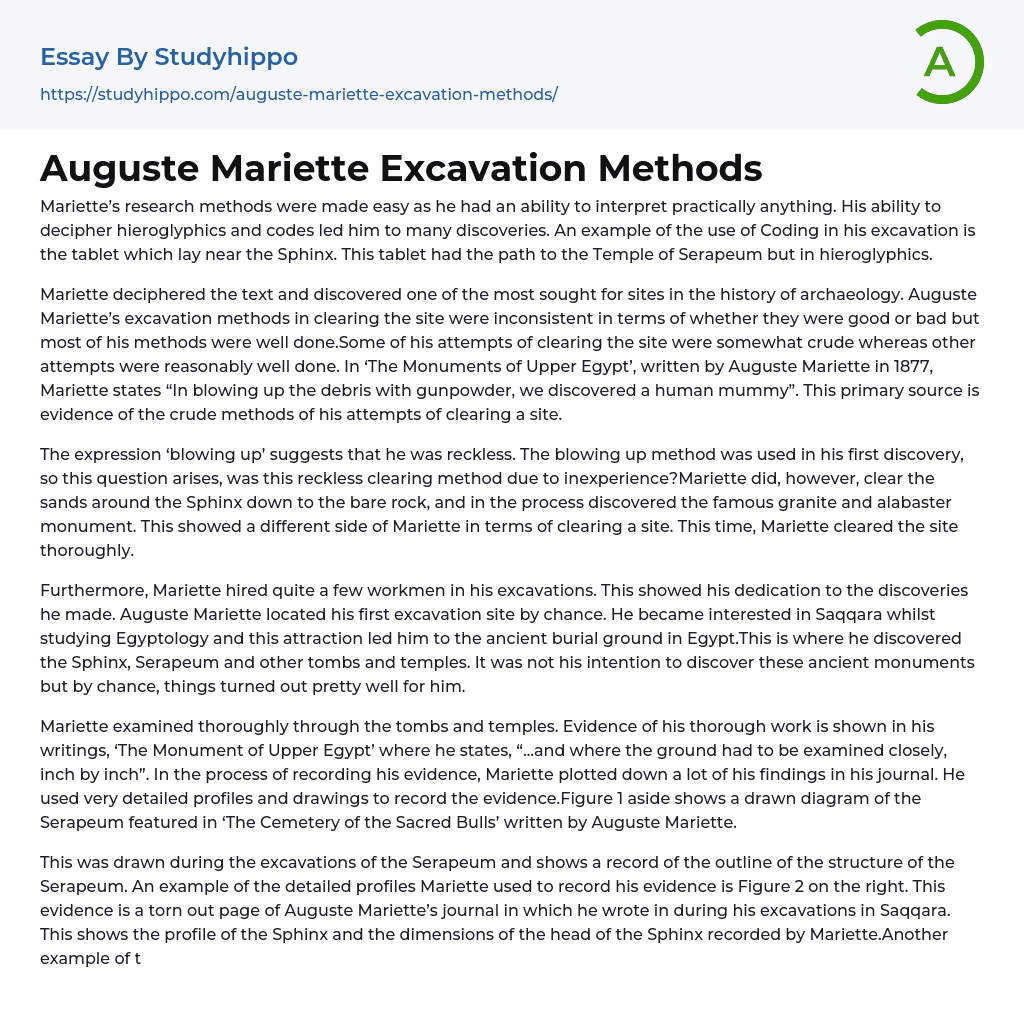Mariette’s research methods were made easy as he had an ability to interpret practically anything. His ability to decipher hieroglyphics and codes led him to many discoveries. An example of the use of Coding in his excavation is the tablet which lay near the Sphinx. This tablet had the path to the Temple of Serapeum but in hieroglyphics.
Mariette deciphered the text and discovered one of the most sought for sites in the history of archaeology. Auguste Mariette’s excavation methods in clearing the site were inconsistent in terms of whether they were good or bad but most of his methods were well done.Some of his attempts of clearing the site were somewhat crude whereas other attempts were reasonably well done. In ‘The Monuments of Upper Egypt’, written by Auguste Mariette in 1877, Mariette states “In blowing up the debris with gunpo
...wder, we discovered a human mummy”. This primary source is evidence of the crude methods of his attempts of clearing a site.
The expression ‘blowing up’ suggests that he was reckless. The blowing up method was used in his first discovery, so this question arises, was this reckless clearing method due to inexperience?Mariette did, however, clear the sands around the Sphinx down to the bare rock, and in the process discovered the famous granite and alabaster monument. This showed a different side of Mariette in terms of clearing a site. This time, Mariette cleared the site thoroughly.
Furthermore, Mariette hired quite a few workmen in his excavations. This showed his dedication to the discoveries he made. Auguste Mariette located his first excavation site by chance. He became interested in Saqqara whilst studying Egyptology and this
attraction led him to the ancient burial ground in Egypt.This is where he discovered the Sphinx, Serapeum and other tombs and temples. It was not his intention to discover these ancient monuments but by chance, things turned out pretty well for him.
Mariette examined thoroughly through the tombs and temples. Evidence of his thorough work is shown in his writings, ‘The Monument of Upper Egypt’ where he states, “…and where the ground had to be examined closely, inch by inch”. In the process of recording his evidence, Mariette plotted down a lot of his findings in his journal. He used very detailed profiles and drawings to record the evidence.Figure 1 aside shows a drawn diagram of the Serapeum featured in ‘The Cemetery of the Sacred Bulls’ written by Auguste Mariette.
This was drawn during the excavations of the Serapeum and shows a record of the outline of the structure of the Serapeum. An example of the detailed profiles Mariette used to record his evidence is Figure 2 on the right. This evidence is a torn out page of Auguste Mariette’s journal in which he wrote in during his excavations in Saqqara. This shows the profile of the Sphinx and the dimensions of the head of the Sphinx recorded by Mariette.Another example of the detailed recordings of Mariette is stated in ‘The Cemetery of the Sacred Bulls’.
In his words, “measure on an average 7 feet 8 inches in breadth, by 13 feet in length, and 1l feet in height”. This is more evidence of his detailed recordings of his discoveries. It shows that he took the time to measure every dimension of objects he found
in his excavations. Bibliography: •http://www.
mnsu. edu/emuseum/information/biography/klmno/mariette_auguste. html •http://en. wikipedia.
org/wiki/Auguste_Mariette •http://www. drshirley. rg/rel433/hist. html •http://www. egyptologyonline.
com/egyptologists. htm •http://weekly. ahram. org. eg/2004/705/he1.
htm •http://www. 1911encyclopedia. org/Auguste_Ferdinand_Francois_Mariette •http://server. egypt. com/egypt/historyen/index. php/Ancient-Egypt-History/Ancient-Egypt-Dynasties/Third-Intermediate-Period-Part-I •http://members.
tripod. com/~ib205/apis_4. html •http://www. aldokkan. com/geography/serapeum.
htm •http://www. phouka. com/pharaoh/egypt/history/egyptologists. html •‘Egypt and the Egyptians’ by Douglas J. Brewer and Emily Teeter
- Animals essays
- Charles Darwin essays
- Agriculture essays
- Archaeology essays
- Moon essays
- Space Exploration essays
- Sun essays
- Universe essays
- Birds essays
- Horse essays
- Bear essays
- Butterfly essays
- Cat essays
- Dolphin essays
- Monkey essays
- Tiger essays
- Whale essays
- Lion essays
- Elephant essays
- Mythology essays
- Time Travel essays
- Discovery essays
- Thomas Edison essays
- Linguistics essays
- Journal essays
- Chemistry essays
- Biology essays
- Physics essays
- Seismology essays
- Reaction Rate essays
- Roman Numerals essays
- Scientific Method essays
- Mineralogy essays
- Plate Tectonics essays
- Logic essays
- Genetics essays
- Albert einstein essays
- Stars essays
- Venus essays
- Mars essays
- Evolution essays
- Human Evolution essays
- Noam Chomsky essays
- Methodology essays
- Eli Whitney essays
- Fish essays
- Dinosaur essays
- Isaac Newton essays
- Progress essays
- Scientist essays




